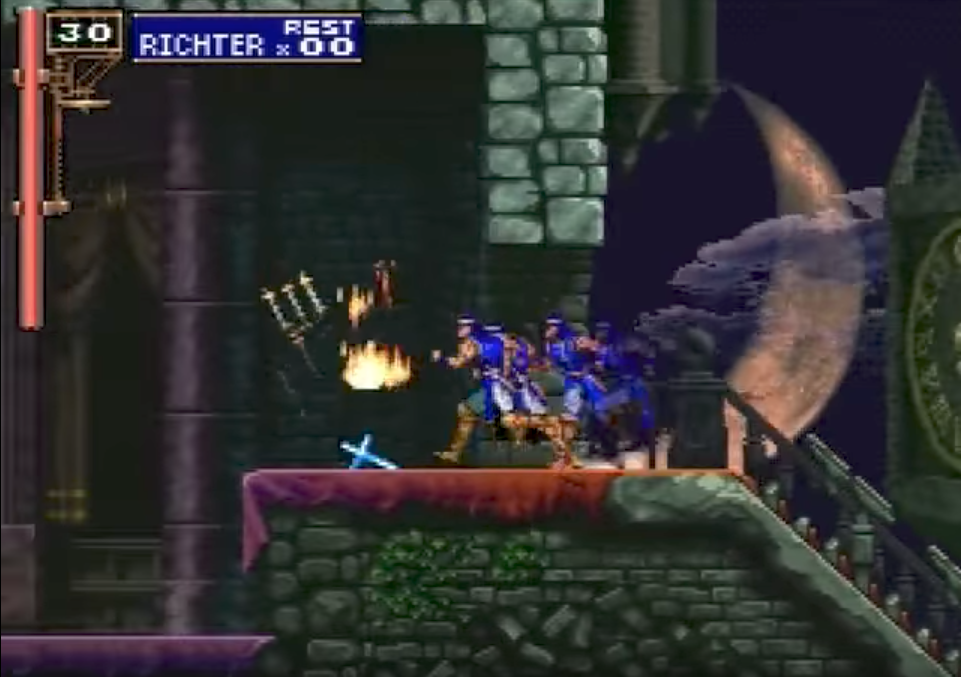Hello All,
I just wanted to share a code snippet I found while searching the internet for some assistance.
In my game, I was thinking of having some trailing shadows like in Castlevania when a special magic spell is activated. Well, I was having a doozy of a time trying to get it to work so I did a search and found that my issue was already solved and the answer was shared with the public. I thought it would be nice to see the solution and give credit where credit is due.
The effect I was trying to achieve was the trailing shadows shown here 
The solution was given by a user named jeffreyschoch in the Unity forums.
[sourcecode language=”csharp”]
using UnityEngine;
using System.Collections;
using System.Collections.Generic;
public class SpriteAfterImage : MonoBehaviour {
[Tooltip("The color each after-image will fade to over its lifetime. Alpha of 0 is recommended")]
public Color finalColor = Color.clear;
[Tooltip("The amount of time an after-image will take to fade away.")]
public float trailLifetime = .25f;
[Tooltip("The distance this object must move to spawn one after-image.")]
public float distancePerSpawn = .1f;
[Tooltip("Optimization – number of after-images to create before the effect starts, to reduce the start-up load.")]
public int spawnOnStart = 0;
private SpriteRenderer mainSpriteRenderer; // the sprite renderer to trail after
private List<SpriteRenderer> readyObjects; // the list of objects ready to be shown
private float distanceTraveledSinceLastSpawn; // the distance this object has moved since the last object was shown
private Vector3 lastSpawnPosition; // the position the last object was spawned
private Color initialColor;
private void Awake() {
// get the sprite renderer on this object
mainSpriteRenderer = GetComponent<SpriteRenderer>();
initialColor = mainSpriteRenderer.color;
// initialize the empty list
readyObjects = new List<SpriteRenderer>();
// optionally populate list beforehand with objects to use
for(int i = 0; i < spawnOnStart; i++) {
readyObjects.Add(makeSpriteObject());
}
}
private void OnEnable() {
StartCoroutine(trailCoroutine());
}
// function to create a sprite gameobject ready for use
private SpriteRenderer makeSpriteObject() {
// create a gameobject named "TrailSprite" with a SpriteRenderer component
GameObject spriteObject = new GameObject("TrailSprite", typeof(SpriteRenderer));
// parent the object to this object so that it follows it
spriteObject.transform.SetParent(transform);
// center it on this object
spriteObject.transform.localPosition = Vector3.zero;
// hide it
spriteObject.SetActive(false);
return spriteObject.GetComponent<SpriteRenderer>();
}
private IEnumerator trailCoroutine() {
// keep running while this component is enabled
while(enabled) {
// get the distance between the current position and the last position
// a trail object was spawned
distanceTraveledSinceLastSpawn = Vector2.Distance(lastSpawnPosition, transform.position);
// if that distance is greater than the specified distance per spawn
if(distanceTraveledSinceLastSpawn > distancePerSpawn) {
// if there aren’t any objects ready to show, spawn a new one
if(readyObjects.Count == 0) {
// add that object’s sprite renderer to the trail list
readyObjects.Add(makeSpriteObject());
}
// get the next object in the ready list
SpriteRenderer nextObject = readyObjects[0];
// set this trailSprite to reflect the current player sprite
nextObject.sprite = mainSpriteRenderer.sprite;
// this makes it so that the trail will render behind the main sprite
nextObject.sortingLayerID = mainSpriteRenderer.sortingLayerID;
nextObject.sortingOrder = mainSpriteRenderer.sortingOrder – 1;
// set it loose in the world
nextObject.transform.SetParent(null, true);
// match the copy’s scale to the sprite’s world-space scale
nextObject.transform.localScale = mainSpriteRenderer.transform.lossyScale;
// show it
nextObject.gameObject.SetActive(true);
// start it fading out over time
StartCoroutine(fadeOut(nextObject));
// remove it from the list of ready objects
readyObjects.Remove(nextObject);
// save this position as the last spawned position
lastSpawnPosition = transform.position;
// reset the distance traveled
distanceTraveledSinceLastSpawn = 0;
}
// wait until next frame to continue the loop
yield return null;
}
// reduce number of sprites back to original pool size
foreach(SpriteRenderer sprite in this.readyObjects) {
if(this.readyObjects.Count > spawnOnStart) {
Destroy(sprite.gameObject);
} else {
resetObject(sprite);
}
}
}
private IEnumerator fadeOut(SpriteRenderer sprite) {
float timeElapsed = 0;
// while the elapsed time is less than the specified trailLifetime
while(timeElapsed < trailLifetime) {
// get a number between 0 and 1 that represents how much time has passed
// 0 = no time has passed, 1 = trailLifetime seconds has passed
float progress = Mathf.Clamp01(timeElapsed / trailLifetime);
// linearly interpolates between the initial color and the final color
// based on the value of progress (0 to 1)
sprite.color = Color.Lerp(initialColor, finalColor, progress);
// track the time passed
timeElapsed += Time.deltaTime;
// wait until next frame to continue the loop
yield return null;
}
// reset the object so that it can be reused
resetObject(sprite);
}
// resets the object so that it is ready to use again
private void resetObject(SpriteRenderer sprite) {
// hide the sprite
sprite.gameObject.SetActive(false);
// reset the tint to default
sprite.color = initialColor;
// parent it to this object
sprite.transform.SetParent(transform);
// center it on this object
sprite.transform.localPosition = Vector3.zero;
// add it to the ready list
readyObjects.Add(sprite);
}
}
[/sourcecode]
You can find the original article located here: https://forum.unity.com/threads/shadow-clones-castlevania-style-2d.482427/
